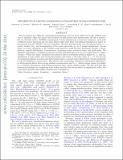THE EFFECTS OF VARYING COSMOLOGICAL PARAMETERS ON HALO SUBSTRUCTURE
Author(s)
Zukin, Phillip; Vogelsberger, Mark; Hernquist, L.; Dooley, Gregory Alan; Ji, Alexander Pung; Frebel, Anna L.; Griffen, Brendan F.; ... Show more Show less
DownloadVogelsberger_The effects.pdf (643.5Kb)
OPEN_ACCESS_POLICY
Open Access Policy
Creative Commons Attribution-Noncommercial-Share Alike
Terms of use
Metadata
Show full item recordAbstract
We investigate how different cosmological parameters, such as those delivered by the WMAP and Planck missions, affect the nature and evolution of the dark matter halo substructure. We use a series of flat Λ cold dark matter cosmological N-body simulations of structure formation, each with a different power spectrum but with the same initial white noise field. Our fiducial simulation is based on parameters from the WMAP seventh year cosmology. We then systematically vary the spectral index, n[subscript s]; matter density, Ω [subscript M]; and normalization of the power spectrum, σ[subscript 8], for seven unique simulations. Across these, we study variations in the subhalo mass function, mass fraction, maximum circular velocity function, spatial distribution, concentration, formation times, accretion times, and peak mass. We eliminate dependence of subhalo properties on host halo mass and average the values over many hosts to reduce variance. While the "same" subhalos from identical initial overdensity peaks in higher σ[subscript 8], n[subscript s], and Ω [subscript m] simulations accrete earlier and end up less massive and closer to the halo center at z = 0, the process of continuous subhalo accretion and destruction leads to a steady state distribution of these properties across all subhalos in a given host. This steady state mechanism eliminates cosmological dependence on all of the properties listed above except for subhalo concentration and V [subscript max], which remain greater for higher σ[subscript 8], n[subscript s], and Ω [subscript m] simulations, and subhalo formation time, which remains earlier. We also find that the numerical technique for computing the scale radius and the halo finder that were used can significantly affect the concentration-mass relationship as computed for a simulation.
Date issued
2014-05Department
Massachusetts Institute of Technology. Department of Physics; MIT Kavli Institute for Astrophysics and Space ResearchJournal
The Astrophysical Journal
Publisher
IOP Publishing
Citation
Dooley, Gregory A., Brendan F. Griffen, Phillip Zukin, Alexander P. Ji, Mark Vogelsberger, Lars E. Hernquist, and Anna Frebel. “THE EFFECTS OF VARYING COSMOLOGICAL PARAMETERS ON HALO SUBSTRUCTURE.” The Astrophysical Journal 786, no. 1 (May 1, 2014): 50.
Version: Author's final manuscript
ISSN
0004-637X
1538-4357